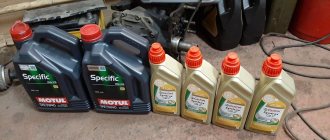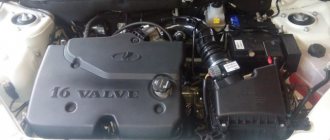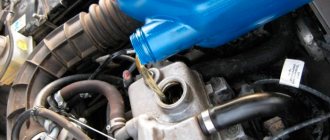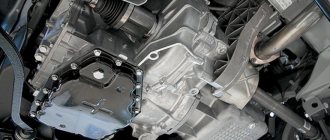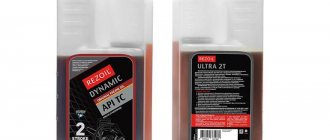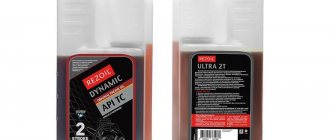Lada Largus is a car jointly produced by the AvtoVAZ and Renault-Nissan concerns, which has several different modifications: Largus R90 - with 5 or 7 seats, F90 - a small cargo van and Cross in black and white. These cars operate on injection 8-valve and 16-valve internal combustion engines, which determines their power - 87 or 105 horsepower, and have environmentally friendly particulate filters and recovery catalysts. The fuel and lubricant is selected according to its characteristics. You can read about what kind of oil to fill into the Lada Largus engine in the documentation supplied with the car - for 16 valves and 8 valves the requirements will be slightly different.
Rules for selecting oil for the LADA Largus engine.
What kind of lubricant is poured into the Lada Largus engine
To determine the type of oil that is poured into the Lada power unit, you need to use the standards offered by the manufacturer in the instructions. For example, for those engines designed for the environmental classes Euro 3 and Euro 4, lubricants with a domestic index are chosen:
- AAI-003 B5;
- AAI-003 B6.
If the lubricant is from a European plant, then when choosing, look at the following indices:
- API SL\SM\SN;
- ACEA A1\A2\A3\A5.
In addition to environmental standards, the level of viscosity is taken into account. Experienced mechanics recommend compounds such as:
- 0W40;
- 5W40;
- 5W30.
To determine more precisely which oil is best to use, you also need to pay attention to the area where the car is operated. For example, in cold regions a less viscous lubricant is poured, but in hot regions of Russia it is more viscous.
Brief excursion
In numerous videos presented on the Internet, you can see this car, get acquainted with its characteristics and watch test drives. The spacious interior and large trunk are impressive, which is very useful for Russians - especially those who like to travel outside the city.
In 2010, Lada Largus was first presented to the public. After 2 years, the first car rolled off the assembly line and industrial production began. The car itself is a copy of the Dacia Logan MCV, presented under license for production at AvtoVAZ. Nowadays, several modifications of the Lada Largus are produced: with a station wagon body capable of accommodating 5 or 7 passengers, as well as with an all-metal body and a 2-seater saloon.
The car is equipped with two French injection engines with a volume of 1.6 liters - with 8 valves and a capacity of 87 hp. With. , as well as a 16-valve engine with a capacity of 105 horses.
A 16-valve engine has two camshafts, an 8-valve engine has one. The car is made on the Renaul Logan platform, and the engines are also taken from there. Transmission – manual 5-speed, French.
In the video you can see how the Lada Largus confidently moves along our roads. This became possible because the suspension, springs and shock absorbers are adapted to Russian road conditions and are designed for increased load capacity. Increased ground clearance also contributes to good cross-country ability.
What original oil is poured into the Lada Largus engine
Original oils supplied by the Rosneft plant have an optimal ratio of additives and an adequate price. Original lubricants from Rosneft:
- Lada Professional 5 W40;
- Lada Ultra 5 W40.
AvtoVAZ poured the following oils into the vehicle engine:
- Shell Helix HX7 5W 40;
- Lukoil Lux 5 W 30.
Attention! Experienced mechanics recommend changing the lubricant in the power unit after 7,000 kilometers. Since the cleaning properties of modern lubricants begin to decrease after 5,000 kilometers. Together with the engine oil, the filter devices in the engine are changed from the factory.
Oil selection table by season (winter, summer)
Oil for VAZ Largus 2012-2014.
| Year | Viscosity SAE all season from +25 to -25 °C | winter from -35 to 0 °C | summer from 0 to +35 °C |
| 0W-40 5W-40 | 20W-40 25W-40 |
| 0W-40 0W-30 5W-40 | 20W-40 25W-40 |
| 0W-40 5W-40 | 20W-40 25W-40 |
+25 to -25 °Cwinter
-35 to 0 °Csummer
from 0 to +35 °CGasoline APIDiesel APITypeRecommended Manufacturers201510W-40 10W-50 15W-40 5W-40
| 0W-40 5W-40 5W-50 | 20W-40 25W-40 25W-50 |
| 0W-40 5W-50 | 20W-40 25W-50 |
| 0W-40 0W-50 | 20W-40 25W-50 |
| 0W-40 0W-50 | 20W-40 25W-50 |
| 0W-50 | 15W-50 20W-50 |
| 0W-50 0W-60 | 15W-50 15W-60 |
Lubricant for gearbox Lada Largus
After 90,000 thousand kilometers, car owners first think about what gear oil to pour into the Largus gearbox. Experienced mechanics recommend not to pour the same lubricant into the mechanics, automatic transmission and variator. For different types of gearboxes, lubricant intended only for it is used.
For your information! Unfortunately, many car owners only have a manual transmission installed in Lada Largus. The automaker tried to install an automatic transmission on the car, but the car with automatic transmission never entered mass production.
Although the manufacturer claims that the oil in the box does not need to be changed, experienced mechanics advise regularly replacing it after 90 thousand kilometers. If the car is used in difficult conditions, then the replacement period is reduced to 60,000 km.
When choosing mechanical oil, you need to pay attention to the viscosity and specification. The SAE marking indicates low temperature and high temperature characteristics. In areas with a temperature of at least 26 degrees with a minus sign, lubricant with the index 80W is poured into the manual transmission. Oil with a specification of 75W is poured in regions with temperatures not lower than 40.
The most commonly used oil that is poured into the Lada Largus box is Elf Tranself NFJ 75W-80. The lubricant belongs to class GL 4+. It is approved by companies such as AvtoVAZ and Renault. Oil is added from the factory. But many motorists replace it with analogues. Experienced mechanics advise that when replacing the original lubricating fluid with an analogue, completely drain the used oil and refill with fresh oil.
As analogues, choose the one that is suitable in terms of viscosity and standard. It is not recommended to change mineral to synthetic and vice versa.
Let's sum it up
High-quality oil for Largus can last for the entire declared period (15 thousand km) and maintain its conditioning properties, the main thing is to know what kind of oil to fill. If you get a low-quality product, you need to replace it as soon as possible. Be careful about the selection process, because the market is full of “high-quality” fakes in terms of colorful packaging. It is very difficult to identify such a fact, so tend to purchase lubricant from trusted and reputable sellers. Don’t skimp on oil and the 8-valve or 16-valve engine of your Lada Largus will be “happiness”!
What is important besides changing the lubricant in the engine and manual transmission
Many car enthusiasts do not like to look under the hood before changing the lubricant. The fact is that during operation, rubber gaskets and seals can harden and leak oil. As a result, lubricant loss begins in these devices. The level decreases, which leads to strange behavior of the car on the roads and ultimately to major repairs.
To prevent this from happening, experienced mechanics advise:
- every 5,000 kilometers check the lubricant level in the engine;
- Every 30,000 kilometers, check the oil level in the manual transmission.
Such simple measures will save the car owner from wasting money. If necessary, it is recommended to add oil to the gearbox or power unit. The engine and manual transmission are pre-serviced. A technical inspection is needed to detect faults that lead to loss of lubricant.
What harms the normal long-term operation of the rubber parts of the engine and mechanics:
- daily delays in traffic jams. The oil in the power unit and gearbox heats up and then cools down; the oil seals expand and contract at a constant frequency, which leads to their wear. And the lubricant itself quickly loses its properties in this case;
- starting the engine cold;
- Frequent travel over short distances. The liquid does not have time to really warm up. Condensation forms. This happens very often in winter.
And condensation dilutes the lubricant, and it loses its protective properties.
Self-replacement
- The first step, after you have decided which oil to pour, will be to position the car above a pit or on an overpass. Can also be hung with a lift.
- We select suitable containers for collecting waste and stock up on the necessary keys.
- Be sure to warm up the engine until it reaches full operating temperature.
- To provide access to the drain plug of the pan, we dismantle the motor protection.
- The plug itself is “defeated” using an “8” size hex wrench.
- We drain the oil completely, waiting for the last drops to disappear. The process will last about 15 minutes.
- Now we can unscrew the old filter. If it is not “stuck”, it will unscrew freely with manual effort. When such manipulation does not work, we use a device (puller). What if there is no puller? We use a screwdriver, which will act as a lever. We use it to pierce the filter housing on the side and away from the motor and rotate it.
- Before installing a new element, lubricate its O-ring (rubber) in a circle with a “drop” of new oil. We screw in the filter only by hand. No devices!
- We also screw the plug into the drain neck of the pan. Do not forget about replacing the copper gasket (“ring”).
- Fill in oil for Largus. Checking the level.
- We start the engine. We look at the level indicator located on the “tidy”. A few seconds (4-5) after the start it should go out.
- Let the engine run for 3-4 minutes and turn it off. After waiting about 10 minutes, we check the level again and draw a conclusion about the need for topping up.
- Once again we inspect the “control” points of the motor (the junction of the filter with the block, plug, etc.) for leaks. If they are missing, install the crankcase protection and go.
Features of 21129 engine/differences
The main feature of the 129 engine is the “innovative” for AvtoVAZ installation of an intake receiver with variable chamber geometry and volume. Due to the damper, the volume of the intake chamber changes depending on the speed. As practice shows, the damper is activated at 3500 engine speeds.
In addition, the engineers managed to get rid of the mass air flow sensor - mass air flow sensor. Along with him, his ailments went away, which tormented the owner of the 21126 engine: unstable idling, sometimes exorbitant consumption, high cost. Instead of mass air flow sensors, engineers installed a connection from DBP and DTV sensors (atmospheric pressure and air temperature sensors). This is where the differences from the 126 engine end. Speaking in fact, the intake system with variable geometry is as old as the world and has been installed by global manufacturers almost since the 80s.
Differences 21129 from 21126 (mounted layout, transition from mass air flow sensor to DBP+DTV, presence of an intake receiver with variable geometry.
Differences between 21129 and 21127 (Different layout, different firmware)
About choosing a filter
The oil filter on the K4M engine must be changed at every oil change. This requirement is more stringent than for 8 valves. On an 8-valve engine, the filter can be replaced “every other time,” although this is contrary to the regulations. But the 16-valve engine is not ready for such “difficulties”.
Articles
The Renault catalog contains two designations - 7700274177 and 8200768913. These are the article numbers for oil filters. But they differ - the first, “shorter” filter comes from the factory.
Filters 7700274177 (left) and 8200768913 (right)
Filter housing height:
- 7700274177 – 49 mm;
- 8200768913 – 53 mm;
- 7700873603 – 55 mm.
You can try the third option at your own risk.
Selection of analogues
- VALEO 586001
- AMC MO441
- GoodWill OG-313
- MecaFilter ELH4196
- Logem LRT-328
- MANN W75/3
- BASBUG BSV7700274177
- MAHLE OC467
- FEBI 27155
- FILTRON OP643/3
- BOSCH 0 451 103 336
- ASAM 30097
- FORTECH FO-018
- PATRON PF4032
- MEYLE 16-14 322 0000
- COOPERSFIAAM FT5902
- MFILTER TF 46
- UFI 23.418.00
- FRAM PH5796
- BLUE PRINT ADC42115
- PURFLUX LS932
- HENGST H11W02
- CHAMPION F136/606
- LYNXauto LC-1400
- CUMMINS HF7615 or LF3494 or LF3714 or LF798
- FORD 5013388 or 5006227
- DEUTZ-FAHR 12850312 or 1052175136
- LIGIER 112397
- NISSAN 15208-00Q0D (H/N/F)
- ALFA ROMEO 0073500506
- MAZDA AM1514302 (55 mm)
- Nevsky filter NF-1018
Secrets of technology
If there is no puller, and you couldn’t unscrew the filter by hand, you can do it simply: take a screwdriver, break through the housing, and unscrew the part counterclockwise. Here the screwdriver is used as a lever.
The filter housing will have to be slightly damaged
The main thing is that the punch hole is closer to the bottom. All actions are carried out from under the hood.
TOTAL QUARTZ 9000 0W30
TOTAL QUARTZ 9000 0W30 engine oil based on synthetic technology has excellent anti-wear and cleaning properties and meets ACEA A5 and API SL standards. TOTAL experts recommend this oil for Lada Largus operating at low temperatures - winter viscosity class 0W - guarantees high fluidity and reliable engine starting even in severe frost. Its viscosity characteristics also reduce friction losses and therefore fuel consumption - up to 2.6% compared to conventional oil, according to ACEA tests. The antioxidant properties of TOTAL QUARTZ 9000 0W30 maintain its effectiveness in all conditions, even after significant miles between replacements.
Recommended engine oil for Lada Largus:
